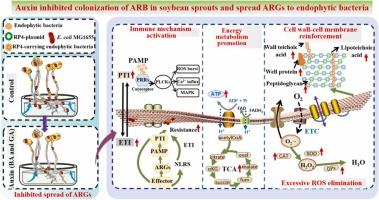生长素抑制大豆芽中耐药菌的定植和耐药基因向内生细菌的传播:强调能量代谢和免疫机制
IF 11.3
1区 环境科学与生态学
Q1 ENGINEERING, ENVIRONMENTAL
引用次数: 0
摘要
抗生素耐药菌(ARB)和抗生素耐药基因(ARGs)广泛存在于蔬菜中,构成健康风险。植物生长素通常用于提高蔬菜产量,但其影响ARGs向内生细菌传播的调节机制尚不清楚。本研究对暴露于赤霉素(GA)和6-苄基腺嘌呤(BA)的大豆芽中ARB的定殖和ARGs在内生细菌中的传播进行了追踪。在大豆芽吸胀期、发芽期和发芽期施用GA和BA均能抑制ARB和ARGs的转移。大豆芽不同组织中ARB和ARGs的富集程度依次为种皮和种皮;下胚轴的在子叶。BA和GA增强了植物细胞壁-细胞膜系统的稳定性,促进了植物体内的能量代谢,激活了免疫机制。其中,GA暴露下植物激素信号转导通路对ARB定植和ARGs转移的抑制作用分别为44.8%和96.7%;植物-病原菌互作途径在BA暴露下对抗生素耐药性的抑制中占主导地位,对ARB定植和ARGs转移的抑制分别占51%和65.9%。这些发现为研究在生长素胁迫下ARB在大豆芽中的定植以及ARGs向内生细菌的传播提供了新的思路。本文章由计算机程序翻译,如有差异,请以英文原文为准。

Auxin inhibited colonization of antibiotic resistant bacteria in soybean sprouts and spread of resistance genes to endophytic bacteria: Highlighting energy metabolism and immunity mechanism
Antibiotic resistant bacteria (ARB) and antibiotic resistance genes (ARGs) are widely in vegetables, posing health risk. Plant auxins are commonly used to enhance vegetable yield, yet the regulatory mechanisms governing their impact on ARGs transmission to endophytic bacteria remain poorly understood. This study tracked ARB colonization and ARGs spread into endophytic bacteria in soybean sprouts exposed to gibberellin (GA) and 6-benzyladenine (BA). The application of GA and BA during the imbibition, sprouting, and germination periods of soybean sprouts all inhibited the transfer of ARB and ARGs. The enrichment of ARB and ARGs in different tissues of soybean sprouts was ranked as seed coat > hypocotyl > cotyledon. BA and GA enhanced the stability of plant cell wall-cell membrane system, promoted energy metabolism in plants, and activated the immunity mechanism. Especially, the plant hormone signal transduction pathway under GA exposure explained 44.8 % and 96.7 % of inhibition on ARB colonization and ARGs transfer, respectively; the plant-pathogen interaction pathway dominated the inhibition of antibiotic resistance under BA exposure, which explained 51 % and 65.9 % of inhibition on ARB colonization and ARGs transfer. These findings provide new insights into ARB colonization in soybean sprouts and the transmission of ARGs to endophytic bacteria under auxin stress.
求助全文
通过发布文献求助,成功后即可免费获取论文全文。
去求助
来源期刊

Journal of Hazardous Materials
工程技术-工程:环境
CiteScore
25.40
自引率
5.90%
发文量
3059
审稿时长
58 days
期刊介绍:
The Journal of Hazardous Materials serves as a global platform for promoting cutting-edge research in the field of Environmental Science and Engineering. Our publication features a wide range of articles, including full-length research papers, review articles, and perspectives, with the aim of enhancing our understanding of the dangers and risks associated with various materials concerning public health and the environment. It is important to note that the term "environmental contaminants" refers specifically to substances that pose hazardous effects through contamination, while excluding those that do not have such impacts on the environment or human health. Moreover, we emphasize the distinction between wastes and hazardous materials in order to provide further clarity on the scope of the journal. We have a keen interest in exploring specific compounds and microbial agents that have adverse effects on the environment.
 求助内容:
求助内容: 应助结果提醒方式:
应助结果提醒方式:


